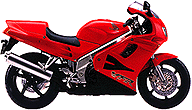

This article was written by David Allan Feller, who has graciously allowed me to post it here. I think it is an excellent article and it has helped me alot.
(Editor's Note: I originally published this story in American Roadracing, September 1994.)
The array of suspension adjustments on modern sportbikes leaves many riders bewildered, wondering where to start. Dale Rathwell, Vance & Hines Yamaha's suspension expert, can end their worries. "I have a procedure that I follow for setting-up suspensions," says Rathwell, "which concentrates in four areas: the springs, ride height and the two damping adjustments--compression and rebound. "The first thing you have to do is establish a baseline for your settings. Always start by setting all adjustments to the manufacturer's suggestions. These are usually found in the service manual, but if not, just ask a racer or knowledgeable mechanic. Then make up a little sheet and record all your settings. This is crucial: Always pay attention to what you're doing and record it, or you'll never get anywhere. "That said, the first thing you need to do is set the suspension's sag."
To do this, it's best to have three people. First, lift the rear end off the ground until the shock is topped out, and measure the distance between the seat and rear axle in a line perpendicular to the ground. Then, wearing your riding gear, sit on the bike, have one helper balance the bike and the other measure the distance between the same two points. Do the same for the front suspension, using a tie-wrap on an O-ring around the inner fork tube. Subtract the compressed measurement from the extended measurement and you have calculated you bike's sag.
"There is a rule of thumb," continues Rathwell, "that says one-quarter to one-third of the usable suspension travel should be used up by the rider in sag, which is necessary to allow the suspension to extend after the bumps that it must compress over. Similarly, if your bike is powerful enough to squat the rear suspension under acceleration, then the front end is not going to stay in contact with the ground if there isn't enough sag."
One problem here, notes Rathwell, is that most sportbikes are equipped with too-soft springs and must be excessively preloaded to achieve the proper sag. This results in a suspension that is too firm in initial movement and then too soft through the rest of the travel--exactly the opposite of what you want. If this is the case with your bike and you plan to retain the stock springs, it may be better to strike a compromise, settling for slightly more than optimum sag in order to reduce preload; too much preload can override the suspension's rebound-damping capabilities.
The next problem to tackle is chassis attitude. This determines how much weight is on each wheel, accomplished by adjusting the ride height. Essentially, you want the bike to steer as fast as possible while maintaining stability and not dragging. This is usually achieved by sliding the forks up in the triple clamps and raising the rear ride height with an adjustable-length aftermarket shock. "The last thing you should do," cautions Rathwell, "is the fine-tuning of the dampers because they're a small part of the picture and only come into play when everything else is properly set. The dampers are there to dissipate energy stored in the springs at a controlled rate (preventing the spring, and motorcycle, from continuing to bounce up and down) and can only be properly set when everything else is correct.
"Begin by making notes detailing what adjustments are available and then, again, establish your starting point from the manufacture's suggestions. Or if that's not available, just start in the middle of all the settings and experiment from there. "Next, move the front and rear compression and rebound adjustments up and down individually throughout their ranges and see what they do. Right away you will have explored the range of adjustments possible and as a rider, will be familiar with how each adjuster makes the chassis react."
From this point on, things get complicated: Too much rebound, for instance, can produce responses similar to insufficient compression damping and vice versa. "There's absolutely no substitute for experience here," stresses Rathwell, "but I can give you some clues. If you've got a lot of chatter in the handlebars when you're not braking, or under light braking, then the spring is loaded and the hydraulics won't allow it to absorb it--too much compression damping. Similarly, in the rear, if you feel a lot of wheel skipping--the wheel feels very light--this is another sign of too much compression.
"Too much rebound is evident, especially in the forks, if you've also got a lot of chatter, but the difference is that it is following the bumps--the suspension is absorbing the bump, but then 'packing' and not riding down the backside. Whereas with too much compression it can't absorb the beginning of the bump and 'jumps' off the crest."
David Allan Feller
